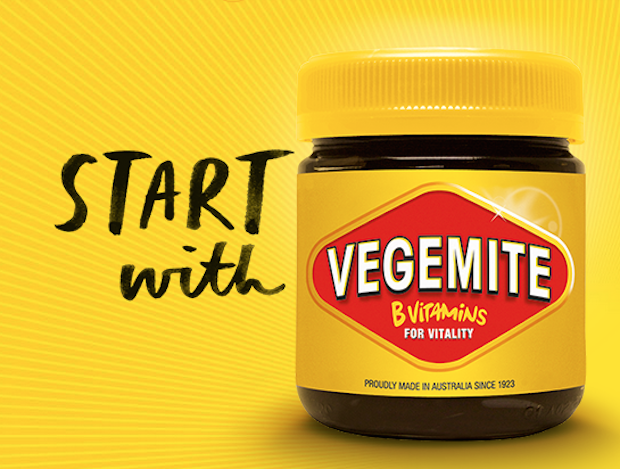SYDNEY, Jan 14 — To the Vegemite virgin, the dark brown paste may look like axle grease and smell like rusty nails, but to many an Aussie, the salty spread is comfortingly delicious, as well as essentially synonymous with Australia itself. It’s a common joke that Vegemite is an Antipodean baby’s first solid food. It’s also routinely cited that Vegemite can be found in the cupboards of at least 80 per cent of Australian homes. What’s more, traveling Aussies don’t leave home without it.
Primarily a yeast extract that remains after the beer brewing process, Vegemite contains few calories and no fat, but a fair amount of sodium. A rich source of B vitamins, which play a role in metabolising macronutrients and in producing energy in the body, Vegemite has routinely been promoted for its purported health benefits. In the late 1930s, its advertising even featured an endorsement from the British Medical Association for its B vitamin content. Although less “veggie” than its name might imply, Vegemite is vegan, vegetarian, certified kosher and certified halal.
Vegemite was developed as a copy of a British product, Marmite, a spread of similar texture and flavour — though it’s best not to say so to a Vegemite die-hard. In the early 1920s, Fred Walker, an Australian entrepreneur, engaged Dr Cyril P. Callister, one of Australia’s first food technologists, to develop the product. After considerable experimentation, Callister developed Vegemite in 1923. Based upon a mutual interest to develop cheeses with a longer shelf life, Walker later combined forces with American cheese producer James Kraft, forming the Kraft Walker Cheese Company in 1926. This partnership eventually resulted in an American company owning Australia’s national food, though Vegemite has always been produced in Australia and from mostly local ingredients.
Despite Vegemite’s widespread popularity today, in its early years the spread was slow to entice Australian appetites, as Marmite held on to a significant portion of the market share. According to Vegemite’s heritage website, however, by the early 1940s Vegemite had become a “staple food in every Australian home and in every Australian pantry.” Over the course of the 20th century, the spread would become an Australian icon.
Try Vegemite this Australia Day
Australia Day, marked each year on January 26, is a national holiday celebrating the day in 1788 when Captain Arthur Phillip and the First Fleet of 11 convict ships from Britain arrived at Sydney Cove. Kraft attempted to cement the connection between the holiday and Vegemite in 2012, the year of the spread’s 89th anniversary. That year, Kraft rebranded Vegemite jars “Australia,” though retaining the recognizable red and yellow colour palette.
One way for an American to celebrate Australia Day is to try Vegemite. The strange truth you’ll have to overcome, however, is that most non-Australians absolutely despise the stuff. With an Australian father, I grew up eating Vegemite and love it, but have yet to convert a single American friend to its delightful, savoury charms. Part of the issue is likely a case of mismatched expectations, since Vegemite looks like chocolate, but tastes like, well, straight up saltiness.
A more apt description of Vegemite’s flavour profile might be umami incarnate. Despite appreciation for other foods boasting savoury, umami flavour — from bacon to Parmesan, soy sauce to mushrooms — most non-Aussies just can’t handle Vegemite. Though Oprah claims to like it, a popular video circulated last year in which 10 American children tasted Vegemite for the first time with dismal results: no tears, but lots of squealing. Suffice it to say, none of them gave Vegemite their kid seal of approval. In 2011, President Barack Obama confessed to then-Australian Prime Minister Julia Gillard that he found the spread “horrible,” disappointing Vegemite lovers. In 2012, singer Niall Horan of the group One Direction echoed this sentiment when he tasted Vegemite toast live on Australian television only to spit it out and later share on Twitter, “Can clearly say vegemite is horrible!”
A ‘culturally specific food’
In 2003, psychology researchers Paul Rozin and Michael Siegal quantifiably confirmed the oft-stated assertion that only Australians enjoy Vegemite. From a survey of 202 participants, the authors concluded, “The eating of this food product and especially the enjoyment of it are specifically linked to Australian birth and ancestry.” They also asserted, “This sticky brown paste remains a candidate for the most culturally specific food.”
The deck may be stacked against Vegemite, but if you’re up to the challenge, start out by trying Vegemite on a slice of hot toast, which is the way most Australians enjoy it at breakfast. Spread the toast first with butter, allowing it to melt in, and then evenly spread a thin layer of Vegemite. A common mistake for first-time Vegemite tasters is to slather it on too thickly like one would peanut butter or a chocolaty spread, an amount unpalatable to even most devoted Vegemite enthusiasts. Recipes from Vegemite’s website suggest you jazz up your Vegemite toast with tomato, egg, cheese or avocado.
If you’re ready to try Vegemite at every meal, you can make turkey burgers, seasoned with Vegemite, onions, rice wine and a touch of sugar, for lunch. Then you can try Vegemite flavoured couscous or sweet potato and rosemary pizza with a Vegemite sauce for dinner.
You just might find that you love Vegemite. If nothing else, it’ll be your saltiest January 26 on record. — Zester Daily/Reuters






















